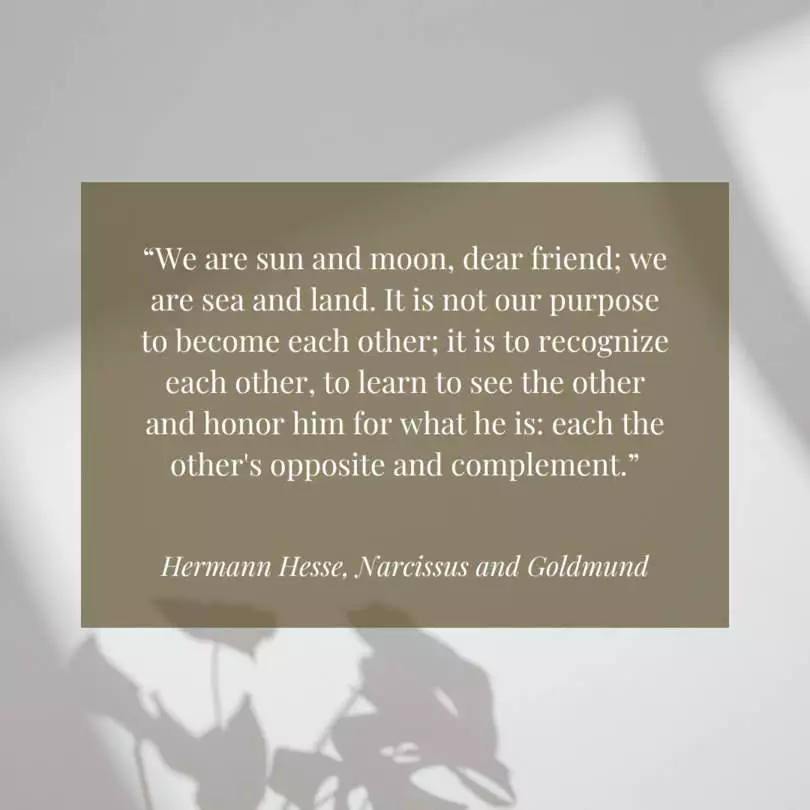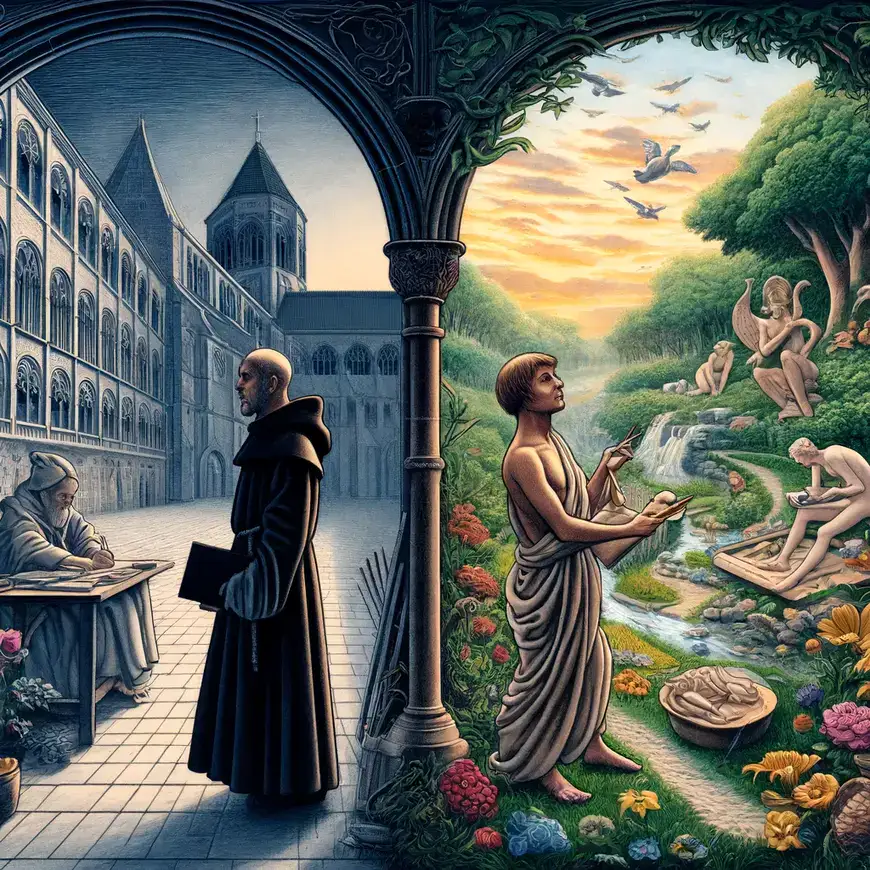A Haunting Journey of Self-Discovery: The Profound Depths of “Narcissus and Goldmund” by Hermann Hesse
In the realm of literary masterpieces, few works possess the ability to penetrate the depths of the human soul and challenge the essence of our existence. Hermann Hesse‘s timeless classic, “Narcissus and Goldmund,” stands as an exquisite testament to the power of introspection and the pursuit of one’s true self. With its mesmerizing prose and thought-provoking themes, this novel takes readers on a haunting journey through the labyrinth of the human psyche.
Set in medieval Germany, “Narcissus and Goldmund” tells the tale of two profoundly different characters whose lives intertwine in a complex dance of friendship, self-discovery, and spiritual awakening. The eponymous protagonists, Narcissus and Goldmund, represent two contrasting paths in life—one driven by reason and intellect, the other by passion and art.
As their lives converge and diverge throughout the narrative, Hesse masterfully explores the dichotomy between the mind and the heart, inviting readers to question the very essence of their own identities.

Remarkable ability to breathe life into his characters
One of the novel’s most striking elements is Hesse’s remarkable ability to breathe life into his characters, endowing them with such depth and complexity that they seem to transcend the page. Narcissus, the intellectual monk, embodies rationality and self-discipline, encapsulating the pursuit of knowledge and spiritual enlightenment.
His steadfast commitment to the monastic life serves as a stark contrast to the enigmatic Goldmund, a restless wanderer and artist driven by an insatiable hunger for experiences and the beauty of the world.
Through the juxtaposition of these two characters, Hesse delves into profound philosophical and existential questions. The dichotomy between reason and passion, mind and body, duty and desire is expertly explored, ultimately inviting readers to contemplate the eternal struggle between conformity and individuality, between societal expectations and the pursuit of personal fulfillment.
Hesse’s poetic and lyrical prose further enhances the ethereal quality of the narrative, drawing readers into a world that pulsates with raw emotions and vivid imagery. Each sentence is meticulously crafted, as if imbued with the author’s own contemplative spirit.
The vivid descriptions of landscapes, art, and the human form become a metaphorical tapestry that unfolds alongside the characters’ journeys, immersing the reader in a multisensory experience that is both intimate and transcendent.
Complex interplay of art and spirituality
Moreover, “Narcissus and Goldmund” delves into the complex interplay of art and spirituality. Goldmund’s exploration of various artistic expressions—sculpture, music, and love—unveils the transformative power of creativity, evoking a profound connection between the artist and the divine.
Hesse’s exploration of the creative process not only celebrates the human capacity for creation but also serves as a reminder of the inherent beauty that lies within each individual.
Beyond its philosophical depth and aesthetic beauty, “Narcissus and Goldmund” ultimately reveals the universality of the human condition. Through the struggles, triumphs, and vulnerabilities of its characters, Hesse invites readers to embark on their own introspective journeys, unearthing the complexities of their own desires, fears, and dreams. The novel serves as a poignant reminder that, regardless of the path we choose, the quest for self-discovery is an integral part of the human experience.

Famous Quotes from Narcissus and Goldmund by Hermann Hesse
- “We are sun and moon, dear friend; we are sea and land. It is not our purpose to become each other; it is to recognize each other, to learn to see the other and honor him for what he is: each the other’s opposite and complement.”
- This quote captures the essence of the novel’s exploration of duality and complementarity. It suggests that individuals are inherently different, embodying contrasting aspects of existence, like the sun and moon or sea and land. The goal is not to eliminate these differences but to recognize and appreciate them. This understanding fosters a harmonious relationship between contrasting forces, acknowledging that one’s strengths complement the other’s weaknesses.
- “His life oscillated, as everyone’s does, not merely between two poles, such as the body and the spirit, the saint and the sinner, but between thousands and thousands.”
- Hesse discusses the complexity of human identity, challenging the notion of binary oppositions. He suggests that a person’s life cannot be neatly categorized into simple dichotomies like body vs. spirit or saint vs. sinner. Instead, it’s a rich tapestry of experiences and aspects that cannot be easily defined or limited. This quote speaks to the multifaceted nature of human beings, each carrying countless potential identities and paths within them.
- “But the fear of the abyss is not the fear of dying, but the fear of living.”
- Here, Hesse delves into the concept of existential dread, not in terms of the fear of death, but the fear of truly living. This quote suggests that the greatest fear people face is not the end of life but the challenges, choices, and responsibilities that come with fully embracing life’s possibilities. It’s a call to confront and engage with life’s depths, rather than shying away from them.
- “The call of death is a call of love. Death can be sweet if we answer it in the affirmative, if we accept it as one of the great eternal forms of life and transformation.”
- This quote reflects Hesse’s philosophical musings on death, framing it not as an end, but as a natural, integral part of life’s cycle. Death, in this view, is not just a cessation but a transition, a transformation that, when embraced, reveals the sweetness and necessity of life’s impermanence. It encourages a perspective of death that is accepting and unafraid, seeing it as a continuation of the cycle of existence.
- “Every man’s life represents a road toward himself.”
- Hesse speaks to the journey of self-discovery and personal growth. This quote encapsulates the idea that each individual’s life is a unique path leading to a deeper understanding of oneself. It suggests that the purpose of life is not found externally but in the journey inward, where one discovers their true essence and potential.

Trivia Facts about “Narcissus and Goldmund”
- Influences and Inspirations:
- Hermann Hesse was deeply influenced by his own spiritual journey and interests in Eastern philosophies and psychoanalysis. The character of Goldmund can be seen as representing the Dionysian aspect of life—emotions, art, and mortality—while Narcissus embodies the Apollonian aspect—rationality, spirituality, and immortality. This duality reflects Hesse’s own inner conflict and his exploration of Carl Jung’s psychological theories.
- Critical Reception and Interpretation:
- Upon its publication, “Narcissus and Goldmund” was met with critical acclaim for its deep philosophical insights and lyrical prose. Critics and scholars have often interpreted the novel as an exploration of the tension between the spiritual and sensual worlds, the intellectual and the artistic, and the journey towards self-realization and enlightenment.
- Autobiographical Elements:
- Like many of Hesse’s works, “Narcissus and Goldmund” contains autobiographical elements. Hesse’s own struggle with authority, society’s expectations, and his quest for spiritual understanding are mirrored in Goldmund’s journey. The novel reflects Hesse’s lifelong quest for self-knowledge and the reconciliation of opposites within the self.
- Nobel Prize in Literature:
- While “Narcissus and Goldmund” is not solely responsible for Hermann Hesse receiving the Nobel Prize in Literature in 1946, the novel is often cited as one of his key works that contributed to his winning the award. The Nobel Prize was awarded to Hesse “for his inspired writings which, while growing in boldness and penetration, exemplify the classical humanitarian ideals and high qualities of style.”
- Influence on Popular Culture:
- “Narcissus and Goldmund” has left a lasting impact on popular culture, influencing various artists, writers, and musicians. The themes of the novel, particularly the quest for meaning and the exploration of the duality of human nature, have resonated with many and have been explored in various mediums beyond literature.
- Translations and Adaptations:
- The novel has been translated into numerous languages, making it accessible to a global audience and securing its place as a work of world literature. Although adaptations of Hesse’s work into film and theater have been less common, “Narcissus and Goldmund” has inspired several adaptations, underscoring its universal themes and enduring appeal.
- Philosophical and Religious Themes:
- The novel is rich in philosophical and religious symbolism, drawing from Christian, Buddhist, and Hindu traditions. The characters of Narcissus and Goldmund are often seen as embodying these varied spiritual perspectives, making the novel a tapestry of Eastern and Western thought.
- A Reflection of Historical Context:
- While the novel is set in a medieval European backdrop, it reflects the universal and timeless questions of human existence. However, its creation was also influenced by the historical context of Hesse’s time, including the aftermath of World War I and the rise of existentialist thought, which sought to find meaning in a post-war world.
Conclussion “Narcissus and Goldmund”
In conclusion, “Narcissus and Goldmund” is a magnum opus that seamlessly weaves together the realms of philosophy, art, and spirituality. Hermann Hesse’s exquisite prose and profound insights into the human psyche make this novel a true masterpiece that continues to captivate readers across generations.
With its haunting beauty and timeless themes, this literary gem invites us to embark on a transformative odyssey of self-discovery. A journey that resonates long after the final page is turned.